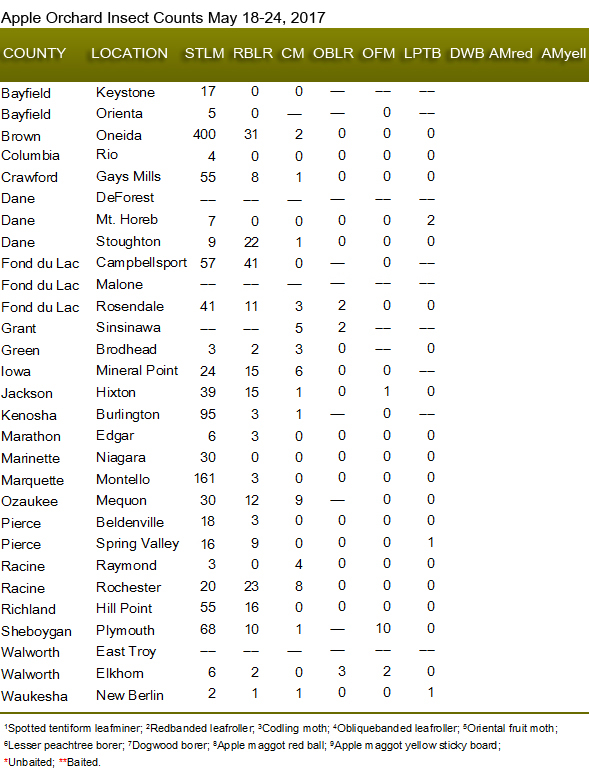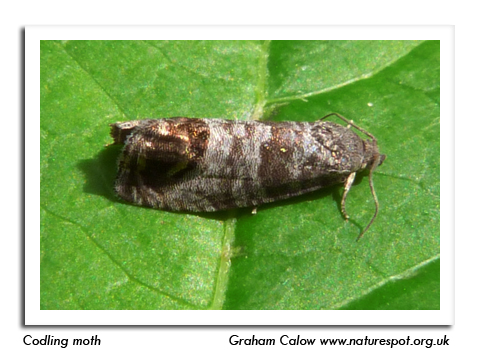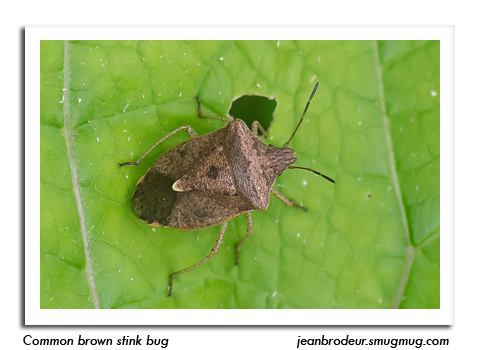
 |
|
|
Fruits
Volume 62 Number 5 Date 05/25/2017 CODLING MOTH - Despite below-normal temperatures, the spring biofix has been set in some southern Wisconsin orchards and growers should make preparations to apply controls at 250 or 350 degree days (modified base 50°F) from their specific biofix date. A first larvicide application made at 250 degree days from the biofix may be considered for orchards that captured higher counts of 5-15 moths last week. Counts in this range suggests there will be enough hatch at 250 degree days to necessitate an earlier CM larvicide treatment. Orchards that register a small and inconsistent early flight, with a larger flight one or two weeks after the biofix, can delay the first spray until 350 degree days and still eliminate most newly-hatched larvae before they enter fruits. OBLIQUEBANDED LEAFROLLER - The first moths are appearing in orchard traps. The adult stage of this insect emerges later than other fruit pests monitored by the DATCP network, around 490 degree days (simple base 43°F). In contrast to the spotted tentiform leafminer and redbanded leafroller, which overwinter as pupae and quickly become moths ready to take flight in April, the obliquebanded leafroller overwinters in the early larval stages and must complete development before moths emerge in late May or early June. SPOTTED TENTIFORM LEAFMINER - Moth numbers were mostly low again this week. Counts ranged from 0-161 per trap and averaged 48 per trap, with the exception of a high capture of 400 moths reported from Brown County. The overall low counts signal that apple orchards are between STLM flights and populations consist primarily of late-instar tissue feeder larvae. Numbers are expected to increase sharply in the next two weeks as the second flight begins. REDBANDED LEAFROLLER - Counts of this pest also remained comparatively low during the May 18-24 reporting period. The first flight peaked about two weeks ago and numbers have been on the decline since then. The second flight should start at most orchard locations by early to mid-June. Apple growers are reminded to replace pheromone lures for both RBLR and STLM in preparation for the second flights. TARNISHED PLANT BUG - Nymph production has started in the south-central and southwestern counties. Strawberry plants beginning to bloom should be checked weekly for both adults and nymphs. Sprays applied against the small, first and second instar stages are very effective and can eliminate the need for a second treatment. The economic threshold for this insect in strawberries is four adults per 20 sweeps at first flower bud formation or one nymph in four flower clusters. NATIVE BROWN STINKBUG - This insect is unusually common this spring and has been collected from about 40% of the alfalfa fields sampled in the last two weeks. A consultant's report indicates that overwintered stink bugs are also appearing on trees in western Wisconsin apple orchards. All of the specimens collected to date have been the native common brown stink bug and not the invasive brown marmorated species. The abundance of stink bugs suggests that eggs are being laid on apple trees and developing fruits could be damaged by feeding nymphs next month. OYSTERSHELL SCALE - Egg hatch and the onset of the first-generation nymph or "crawler" period was noted on May 18 in Trempealeau County. The appearance of the dispersal stage indicates that treatments for control of oystershell scale in orchards should begin promptly. For smaller infestations in yards or on ornamental trees, the scale coverings and crawlers can be destroyed by scrubbing the bark with a soft plastic pad. Very heavily infested branches may need to be pruned. Activity by the mobile stage extends only for 1-2 weeks before the crawlers settle onto branches and develop protective waxy covers. Apple growers in central and eastern Wisconsin should begin scouting for crawlers in the week ahead. PLUM CURCULIO - Weevil migration into orchard edges continued this week and feeding and oviposition scars are appearing on apples and plums. Growers who applied a PC petal fall treatment should be aware that recent wet weather likely degraded efficacy of insecticides and a perimeter application may be needed 7-10 days following a petal fall spray to prevent further migration of PC into the orchard. -- Krista Hamilton, DATCP Entomologist 





|
|
|